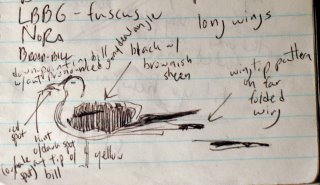More records of this species accumulated, at first slowly but then more quickly, so that the Lesser Black-backed Gull is now a regular part of NJ's avifauna. Walsh et al. (1999) give a high count of 53 birds at Florence in Burlington County on 20 March 1997. Florence, of course, is just across the Delaware River from the massive Tullytown dump in Pennsylvania, a location that concentrates gulls. That high count has since been eclipsed on more than one occasion; the current state high count of Lesser Black-backed Gulls was made by Ward Dasey at Florence on 15 November 2003 and amounted to 214+ birds (Driver 2004). As numbers have increased, so have sightings of immature birds, and records can now be found throughout the year, even during the summer. It seems probable that this species must nest somewhere in North America, but there is still no hard proof. Sightings have increased across the country, but the East Coast is still this species' stronghold.
Walsh et al. state that southward-bound migrants occur "early in the fall, usually by mid-September." This fits perfectly with the date of the first record. Although graellsii of western Europe is the expected subspecies, Edwards' description of the first NJ bird states that the bird's back color appeared to be the same as that of Great Black-backed Gulls nearby; the observers circled the bird to make sure that the angle of the light was not affecting the bird's appearance. As a result, the observers thought that the subspecies involved was fuscus, which is native to northern Scandinavia. Adult birds of the subspecies intermedius, which occurs further south in Scandinavia, also have a black mantle, while adult graellsii birds have a slaty mantle that contrasts with black wingtips. Today's birders also have to consider the so-called "Dutch intergrades" between graellsii and intermedius when confronted by a Lesser Black-backed Gull with a darker-than-normal mantle (Post & Lewis 1995). Light conditions and the angle of the bird respective to the observer can also make dramatic differences in the apparent shade of a gull's mantle.
As anyone who has dabbled in gull identification knows, it is often a frustrating pursuit. However, I still find that a day with an elegant, long-winged Lesser Black-backed Gull on the list is a good day in the field.

(Illustrative disclaimer: these field notes were not taken in NJ. They were actually taken at the Kuusamo dump in Finland, and they attempt to depict an adult fuscus Lesser Black-back.)
Driver, Paul J. 2004. 2003 Fall Field Notes, Region 4. New Jersey Birds 30:15-18.
Edwards, James L. 1935. The Lesser Black-backed Gull in New Jersey. Auk 52:85. PDF here
Post, Peter W., & Robert H. Lewis. 1995. The Lesser Black-backed Gull in the Americas: Occurrence and Subspecific Identity. Birding 27:282-290; 370-380.
Walsh, Joan, Vince Elia, Rich Kane, & Thomas Halliwell. 1999. Birds of New Jersey. New Jersey Audubon Society, Bernardsville, NJ.
No comments:
Post a Comment